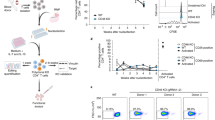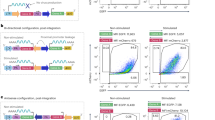Abstract
Resting human CD4 T cells are highly resistant to transfection or infection with lentiviral vectors derived from the human immunodeficiency virus. We now describe a flexible and efficient approach involving virus-like particles containing simian immunodeficiency virus lentiviral gene product protein X and pseudotyping with CXCR4-tropic HIV Env. This method permits effective genetic manipulation of these cells while preserving their naturally quiescent state. This technology can also be extended to primary lymphoid cultures where authentic cellular composition and functional relationships are preserved.
This is a preview of subscription content, access via your institution
Access options
Subscribe to this journal
Receive 12 print issues and online access
$259.00 per year
only $21.58 per issue
Buy this article
- Purchase on Springer Link
- Instant access to full article PDF
Prices may be subject to local taxes which are calculated during checkout


Similar content being viewed by others
References
Wambre E, James EA, Kwok WW . Characterization of CD4+ T cell subsets in allergy. Curr Opin Immunol 2012; 24: 700–706.
Rice GI, Bond J, Asipu A, Brunette RL, Manfield IW, Carr IM et al. Mutations involved in Aicardi-Goutieres syndrome implicate SAMHD1 as regulator of the innate immune response. Nat Genet 2009; 41: 829–832.
Stetson DB, Ko JS, Heidmann T, Medzhitov R . Trex1 prevents cell-intrinsic initiation of autoimmunity. Cell 2008; 134: 587–598.
Moir S, Chun TW, Fauci AS . Pathogenic mechanisms of HIV disease. Annu Rev Pathol 2011; 6: 223–248.
Glushakova S, Baibakov B, Margolis LB, Zimmerberg J . Infection of human tonsil histocultures: a model for HIV pathogenesis. Nat Med 1995; 1: 1320–1322.
Suzuki H, Zelphati O, Hildebrand G, Leserman L . CD4 and CD7 molecules as targets for drug delivery from antibody bearing liposomes. Exp Cell Res 1991; 193: 112–119.
Wheeler LA, Trifonova R, Vrbanac V, Basar E, McKernan S, Xu Z et al. Inhibition of HIV transmission in human cervicovaginal explants and humanized mice using CD4 aptamer-siRNA chimeras. J Clin Invest 2011; 121: 2401–2412.
Tahvanainen J, Pykalainen M, Kallonen T, Lahteenmaki H, Rasool O, Lahesmaa R . Enrichment of nucleofected primary human CD4+ T cells: a novel and efficient method for studying gene function and role in human primary T helper cell differentiation. J Immunol Methods 2006; 310: 30–39.
Eguchi A, Meade BR, Chang YC, Fredrickson CT, Willert K, Puri N et al. Efficient siRNA delivery into primary cells by a peptide transduction domain-dsRNA binding domain fusion protein. Nat Biotechnol 2009; 27: 567–571.
Naldini L . Lentiviruses as gene transfer agents for delivery to non-dividing cells. Curr Opin Biotechnol 1998; 9: 457–463.
Baldauf HM, Pan X, Erikson E, Schmidt S, Daddacha W, Burggraf M et al. SAMHD1 restricts HIV-1 infection in resting CD4(+) T cells. Nat Med 2012; 18: 1682–1689.
Doitsh G, Cavrois M, Lassen KG, Zepeda O, Yang Z, Santiago ML et al. Abortive HIV infection mediates CD4 T cell depletion and inflammation in human lymphoid tissue. Cell 2010; 143: 789–801.
Zack JA, Arrigo SJ, Weitsman SR, Go AS, Haislip A, Chen IS . HIV-1 entry into quiescent primary lymphocytes: molecular analysis reveals a labile, latent viral structure. Cell 1990; 61: 213–222.
Zhou Y, Zhang H, Siliciano JD, Siliciano RF . Kinetics of human immunodeficiency virus type 1 decay following entry into resting CD4+ T cells. J Virol 2005; 79: 2199–2210.
Swiggard WJ, O'Doherty U, McGain D, Jeyakumar D, Malim MH . Long HIV type 1 reverse transcripts can accumulate stably within resting CD4+ T cells while short ones are degraded. AIDS Res Hum Retroviruses 2004; 20: 285–295.
Swiggard WJ, Baytop C, Yu JJ, Dai J, Li C, Schretzenmair R et al. Human immunodeficiency virus type 1 can establish latent infection in resting CD4+ T cells in the absence of activating stimuli. J Virol 2005; 79: 14179–14188.
Dai J, Agosto LM, Baytop C, Yu JJ, Pace MJ, Liszewski MK et al. Human immunodeficiency virus integrates directly into naive resting CD4+ T cells but enters naive cells less efficiently than memory cells. J Virol 2009; 83: 4528–4537.
Derdouch S, Gay W, Negre D, Prost S, Le Dantec M, Delache B et al. Reconstitution of the myeloid and lymphoid compartments after the transplantation of autologous and genetically modified CD34+ bone marrow cells, following gamma irradiation in cynomolgus macaques. Retrovirology 2008; 5: 50.
Pace MJ, Graf EH, Agosto LM, Mexas AM, Male F, Brady T et al. Directly infected resting CD4+T cells can produce HIV Gag without spreading infection in a model of HIV latency. PLoS Pathog 2012; 8: e1002818.
Wu Y, Marsh JW . Selective transcription and modulation of resting T cell activity by preintegrated HIV DNA. Science 2001; 293: 1503–1506.
Spina CA, Guatelli JC, Richman DD . Establishment of a stable, inducible form of human immunodeficiency virus type 1 DNA in quiescent CD4 lymphocytes in vitro. J Virol 1995; 69: 2977–2988.
Laguette N, Sobhian B, Casartelli N, Ringeard M, Chable-Bessia C, Segeral E et al. SAMHD1 is the dendritic- and myeloid-cell-specific HIV-1 restriction factor counteracted by Vpx. Nature 2011; 474: 654–657.
Vigna E, Naldini L . Lentiviral vectors: excellent tools for experimental gene transfer and promising candidates for gene therapy. J Gene Med 2000; 2: 308–316.
Agosto LM, Yu JJ, Liszewski MK, Baytop C, Korokhov N, Humeau LM et al. The CXCR4-tropic human immunodeficiency virus envelope promotes more-efficient gene delivery to resting CD4+ T cells than the vesicular stomatitis virus glycoprotein G envelope. J Virol 2009; 83: 8153–8162.
Yu D, Wang W, Yoder A, Spear M, Wu Y . The HIV envelope but not VSV glycoprotein is capable of mediating HIV latent infection of resting CD4 T cells. PLoS Pathog 2009; 5: e1000633.
Negre D, Mangeot PE, Duisit G, Blanchard S, Vidalain PO, Leissner P et al. Characterization of novel safe lentiviral vectors derived from simian immunodeficiency virus (SIVmac251) that efficiently transduce mature human dendritic cells. Gene Ther 2000; 7: 1613–1623.
Ventura A, Meissner A, Dillon CP, McManus M, Sharp PA, Van Parijs L et al. Cre-lox-regulated conditional RNA interference from transgenes. Proc Natl Acad Sci USA 2004; 101: 10380–10385.
Kreisberg JF, Yonemoto W, Greene WC . Endogenous factors enhance HIV infection of tissue naive CD4 T cells by stimulating high molecular mass APOBEC3G complex formation. J Exp Med 2006; 203: 865–870.
Plesa G, Dai J, Baytop C, Riley JL, June CH, O'Doherty U . Addition of deoxynucleosides enhances human immunodeficiency virus type 1 integration and 2LTR formation in resting CD4+ T cells. J Virol 2007; 81: 13938–13942.
Korin YD, Zack JA . Progression to the G1b phase of the cell cycle is required for completion of human immunodeficiency virus type 1 reverse transcription in T cells. J Virol 1998; 72: 3161–3168.
White TE, Brandariz-Nunez A, Valle-Casuso JC, Amie S, Nguyen LA, Kim B et al. The retroviral restriction ability of SAMHD1, but not its deoxynucleotide triphosphohydrolase activity, is regulated by phosphorylation. Cell Host Microbe 2013; 13: 441–451.
Mariathasan S, Weiss DS, Newton K, McBride J, O'Rourke K, Roose-Girma M et al. Cryopyrin activates the inflammasome in response to toxins and ATP. Nature 2006; 440: 228–232.
Doitsh G, Galloway NLK, Geng X, Yang Z, Monroe KM, Zepeda O et al. Cell death by pyroptosis drives CD4 T-cell depletion in HIV-1 infection. Nature 2014; 505: 509–514.
Guo J, Wang W, Yu D, Wu Y . Spinoculation triggers dynamic actin and cofilin activity that facilitates HIV-1 infection of transformed and resting CD4 T cells. J Virol 2011; 85: 9824–9833.
O'Doherty U, Swiggard WJ, Malim MH . Human immunodeficiency virus type 1 spinoculation enhances infection through virus binding. J Virol 2000; 74: 10074–10080.
Berger G, Durand S, Goujon C, Nguyen XN, Cordeil S, Darlix JL et al. A simple, versatile and efficient method to genetically modify human monocyte-derived dendritic cells with HIV-1-derived lentiviral vectors. Nat Protoc 2011; 6: 806–816.
Bobadilla S, Sunseri N, Landau NR . Efficient transduction of myeloid cells by an HIV-1-derived lentiviral vector that packages the Vpx accessory protein. Gene Ther 2013; 20: 514–520.
Monroe KM, Yang Z, Johnson JR, Geng X, Doitsh G, Krogan NJ et al. IFI16 DNA Sensor Is Required for Death of Lymphoid CD4 T-cells Abortively Infected with HIV. Science 2014; 343: 428–432.
Siliciano RF, Greene WC . HIV latency. Cold Spring Harb Perspect Med 2011; 1: a007096.
Goujon C, Jarrosson-Wuilleme L, Bernaud J, Rigal D, Darlix JL, Cimarelli A . With a little help from a friend: increasing HIV transduction of monocyte-derived dendritic cells with virion-like particles of SIV(MAC). Gene Ther 2006; 13: 991–994.
Dzionek A, Fuchs A, Schmidt P, Cremer S, Zysk M, Miltenyi S et al. BDCA-2, BDCA-3, and BDCA-4: three markers for distinct subsets of dendritic cells in human peripheral blood. J Immunol 2000; 165: 6037–6046.
Hrecka K, Hao C, Gierszewska M, Swanson SK, Kesik-Brodacka M, Srivastava S et al. Vpx relieves inhibition of HIV-1 infection of macrophages mediated by the SAMHD1 protein. Nature 2011; 474: 658–661.
Wissing S, Montano M, Garcia-Perez JL, Moran JV, Greene WC . Endogenous APOBEC3B restricts LINE-1 retrotransposition in transformed cells and human embryonic stem cells. J Biol Chem 2011; 286: 36427–36437.
Grivel JC, Elliott J, Lisco A, Biancotto A, Condack C, Shattock RJ et al. HIV-1 pathogenesis differs in rectosigmoid and tonsillar tissues infected ex vivo with CCR5- and CXCR4-tropic HIV-1. AIDS 2007; 21: 1263–1272.
Cavrois M, De Noronha C, Greene WC . A sensitive and specific enzyme-based assay detecting HIV-1 virion fusion in primary T lymphocytes. Nat Biotechnol 2002; 20: 1151–1154.
Acknowledgements
We thank Dr Matthew Spindler in the laboratory of Dr Bruce Conklin for the generous gift of pSico-mCherry HIV LV vector. We thank Dr Marielle Cavrois, Marianne Gesner and Jaime Tawney for assistance with flow cytometry. We also thank Dr Gary Howard, Crystal Herron and Dr Anna Lisa Lucido for editorial assistance, John C.W. Carroll, Giovanni Maki and Teresa Roberts for graphics arts, and Robin Givens and Sue Cammack for administrative assistance. Special thanks to Jason Neidleman for stimulating discussions and technical advice. Funding for this project was provided by the UCSF/Robert John Sabo Trust Award (GD), NIH/NIAID R21 AI102782 (WCG), 1DP11036502 (WCG) and NIH/NIAID U19 AI096113 (WCG). We thank the UCSF-GIVI CFAR for providing core services that facilitated these studies (CFAR P30 AI027763).
Author information
Authors and Affiliations
Corresponding author
Ethics declarations
Competing interests
The authors declare no conflict of interest.
Additional information
Supplementary Information accompanies this paper on Gene Therapy website
Supplementary information
Rights and permissions
About this article
Cite this article
Geng, X., Doitsh, G., Yang, Z. et al. Efficient delivery of lentiviral vectors into resting human CD4 T cells. Gene Ther 21, 444–449 (2014). https://doi.org/10.1038/gt.2014.5
Received:
Revised:
Accepted:
Published:
Issue Date:
DOI: https://doi.org/10.1038/gt.2014.5
Keywords
This article is cited by
-
Editing naive CD4+ T cells
Nature Methods (2022)
-
FOXO1 promotes HIV latency by suppressing ER stress in T cells
Nature Microbiology (2020)
-
Cyclosporine H Improves the Multi-Vector Lentiviral Transduction of Murine Haematopoietic Progenitors and Stem Cells
Scientific Reports (2020)
-
miR-106a deficiency attenuates inflammation in murine IBD models
Mucosal Immunology (2019)
-
Purification of virus-like particles (VLPs) expressed in the silkworm Bombyx mori
Biotechnology Letters (2018)



